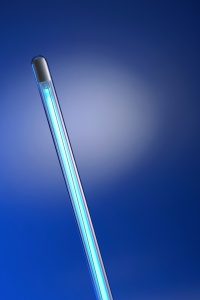 As summer approaches, so does humidity, and along with humidity comes some byproducts, like the development of mold and mildew. These can cause significant ill health effects, especially for people who already suffer from allergies or asthma.
As summer approaches, so does humidity, and along with humidity comes some byproducts, like the development of mold and mildew. These can cause significant ill health effects, especially for people who already suffer from allergies or asthma.
One way to fight back against this is to have germicidal lights installed in your HVAC ductwork. These devices use ultraviolet radiation within your ventilation system to kill, or render inert, bacteria, mold spores, viruses, and microorganisms. They’re effective, don’t place harmful chemicals into the air, and require little maintenance.
“Where Do Germicidal Lights Go?”
Also called UV lights or a UV air purifier, germicidal lights are a set of UV lightbulbs that emit the ultraviolet radiation that destroys cellular material, and are installed right into your HVAC system’s ductwork.
The UV level of germicidal lights is harmless for humans and pets, but deadly to smaller organic particles. These lights are positioned in the system so they shine on the evaporator coil of your air conditioner—the point where all air must pass.
Protecting Your Indoor Air and Your HVAC System
UV radiation eliminates mold and mold spores, along with other organic pollutants. Mold is a major issue for your indoor air quality, but also to your AC system. As the evaporator coil operates, it draws water vapor out of the air along with the heat. In a climate like ours, where there is plenty of water vapor, an air conditioner has to remove a lot of water condensation from the coils. Sometimes, there’s too much water left behind, and mold occurs.
The reasons this is a problem for your AC system is that it can send out toxic mold sports along with your conditioned air—a major source of asthma and illness in a household. Secondly, mold creates a terrible, musty smell. This is known as “dirty sock syndrome” and affects many AC systems.
Ultimately, mold can damage the evaporator coil and make it harder for the system to pull heat from the air. As the mold expands on the coil, the air conditioner will begin losing energy efficiency as well as cooling power.
Can a Dehumidifier Help?
Yes! Many people think that their air conditioners serve as effective dehumidifiers. Cooling systems do have some dehumidification properties, since lowering the temperature of a room lowers the humidity of it. But that moisture needs somewhere to go—which is that condensation we mentioned above. Letting a whole-house dehumidifier take over in this task will help your indoor air quality, your comfort, and the air conditioner itself.
The relative humidity level in any home shouldn’t be above 50% (or below 30%, for that matter). So the installation of a whole-house dehumidifier is definitely a good idea.
But, this doesn’t mean you can’t also utilize germicidal lights! In fact, for optimal comfort and energy savings, we recommend investing in both a dehumidifier and germicidal lights.
When you’re in need of a professional HVAC company in Lawrenceville, GA, contact Wall Heating & Air Conditioning, Inc. today!
